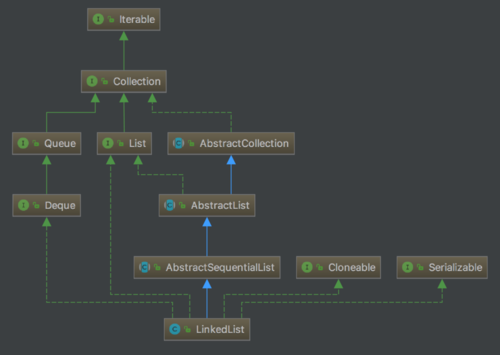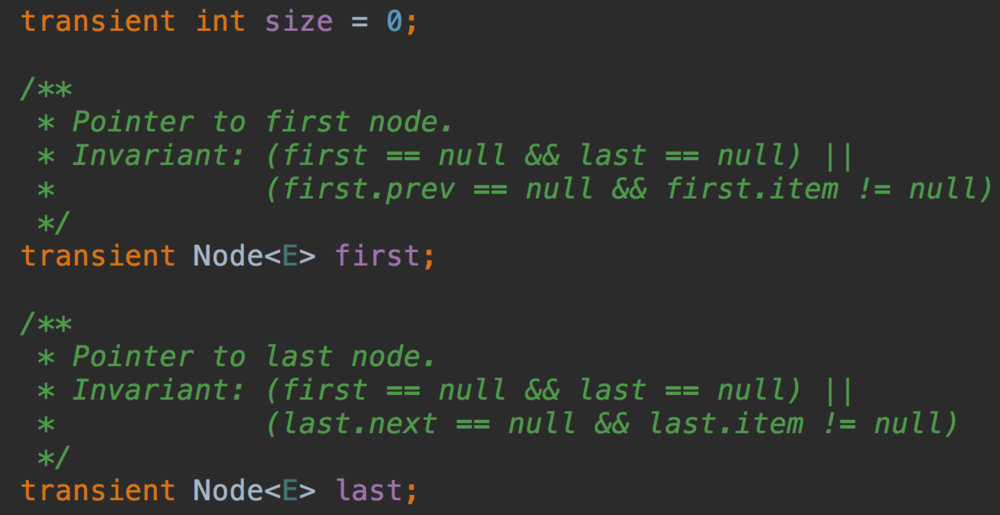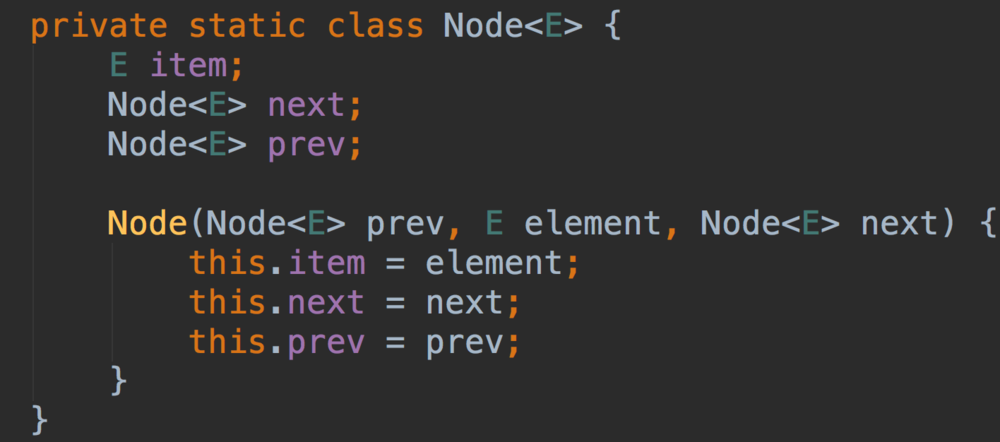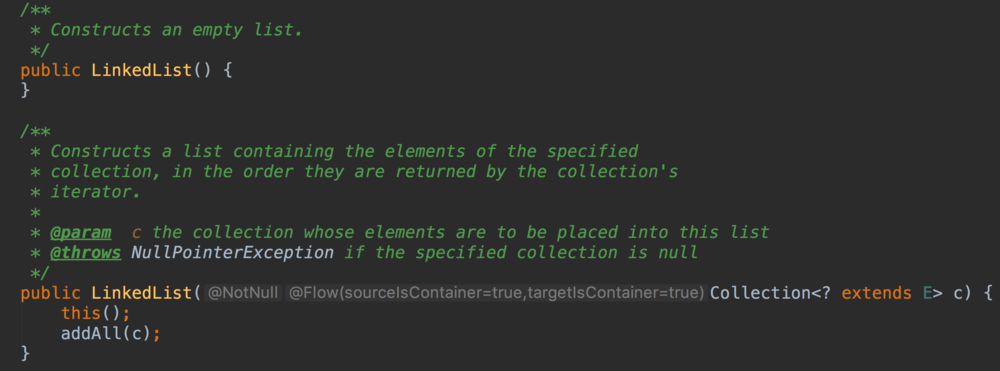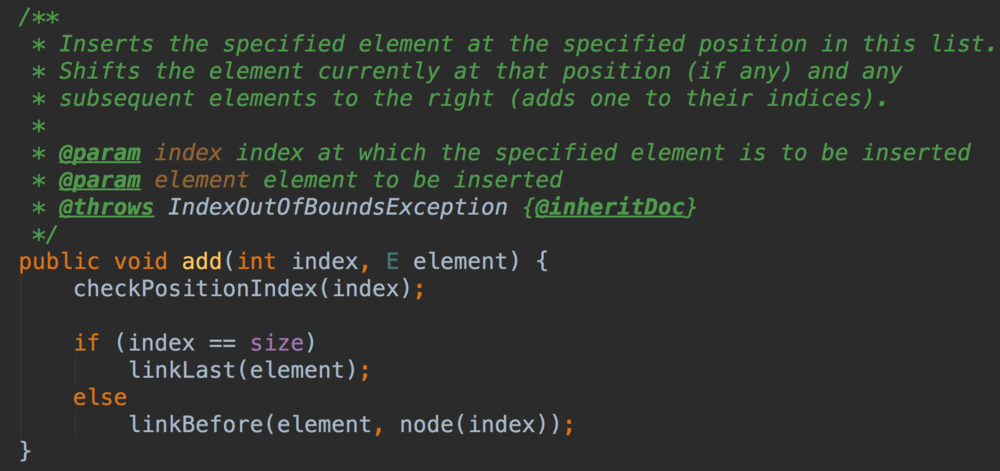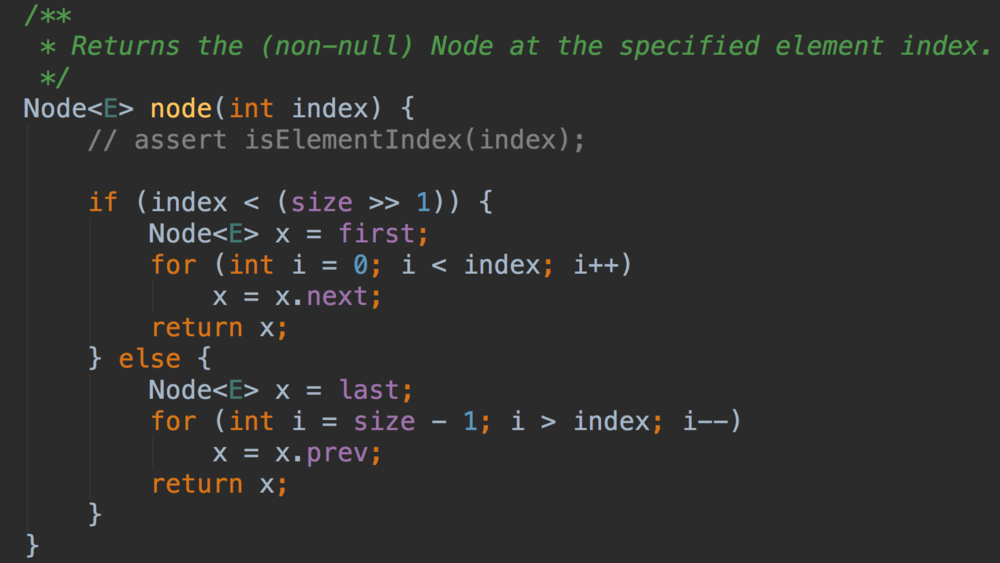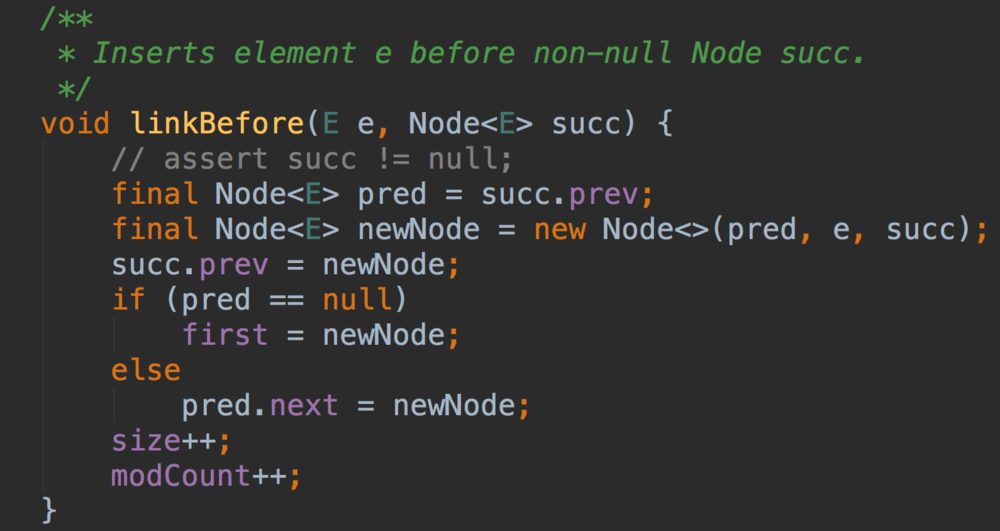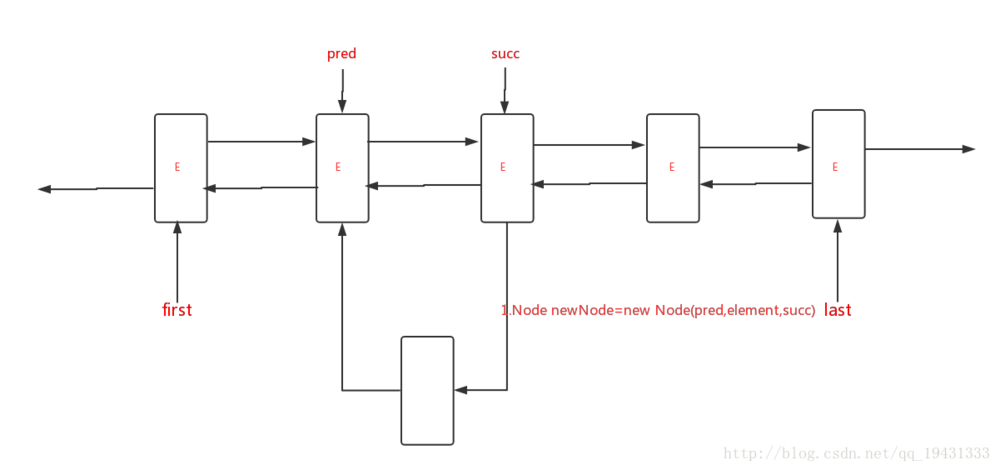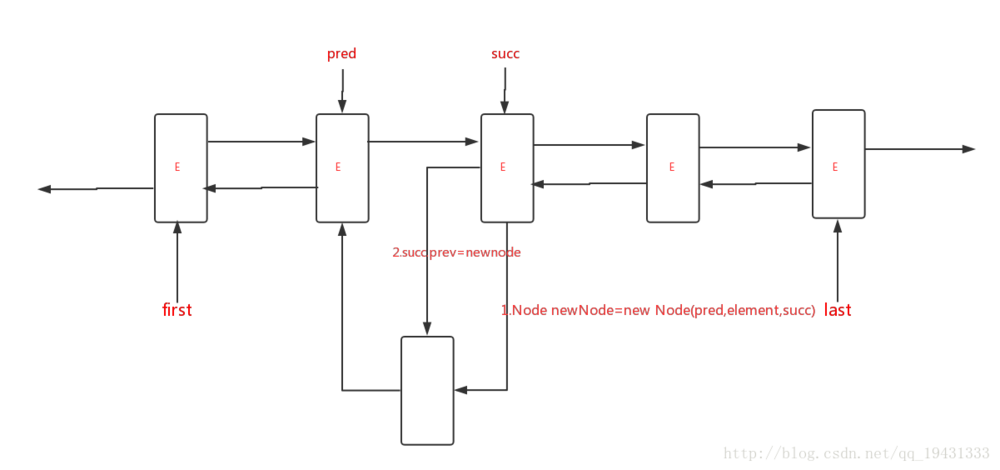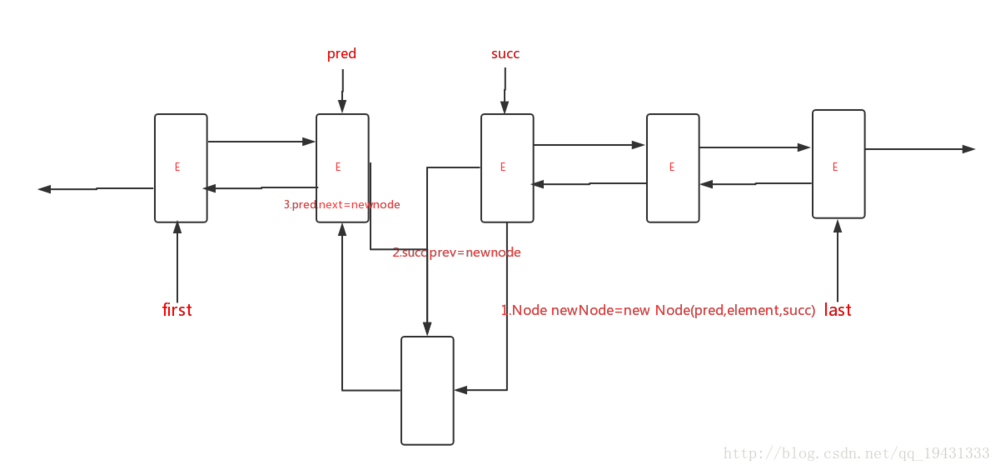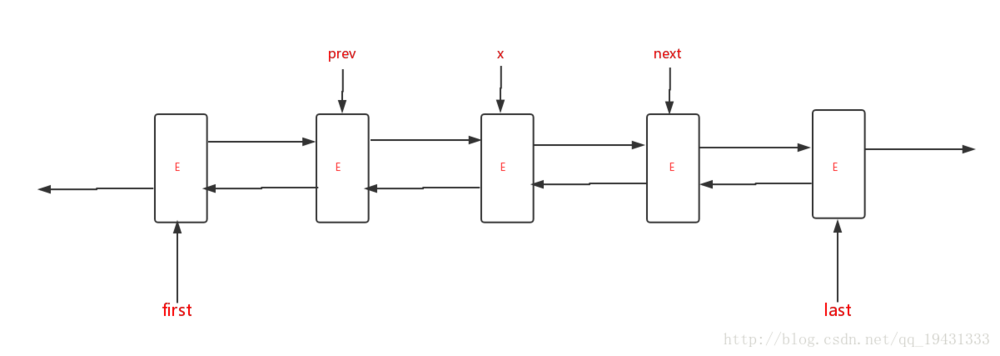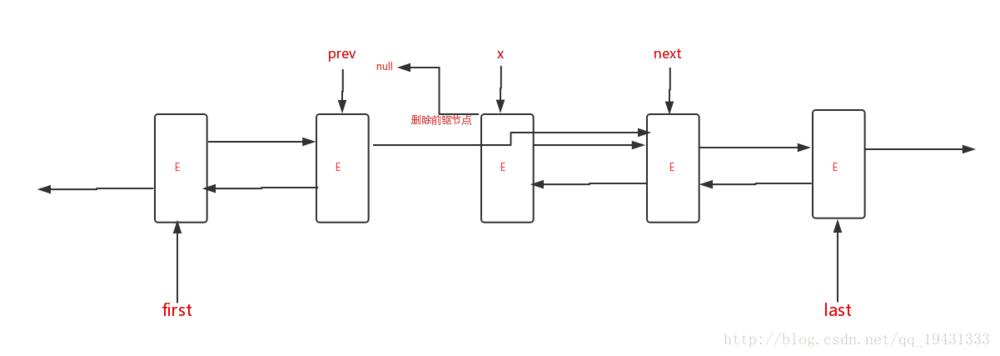LinkedList是一个实现了List接口和Deque接口的双端链表
有关索引的操作可能从链表头开始遍历到链表尾部,也可能从尾部遍历到链表头部,这取决于看索引更靠近哪一端。
LinkedList不是线程安全的,如果想使LinkedList变成线程安全的,可以使用如下方式:
List list=Collections.synchronizedList(new LinkedList(...));
iterator()和listIterator()返回的迭代器都遵循fail-fast机制。
从上图可以看出LinkedList与ArrayList的不同之处
ArrayList直接继承自AbstractList
LinkedList继承自AbstractSequentialList,然后再继承自AbstractList。另外还实现了Dequeu接口,双端队列。
内部结构
LinkedList内部是一个双端链表的结构
LinkedList的结构
从上图可以看出,LinkedList内部是一个双端链表结构,有两个变量,first指向链表头部,last指向链表尾部。
成员变量
size表示当前链表中的数据个数
下面是Node节点的定义,LinkedList的静态内部类
从Node的定义可以看出链表是一个双端链表的结构。
构造方法
LinkedList有两个构造方法,一个用于构造一个空的链表,一个用已有的集合创建链表
添加
因为LinkedList即实现了List接口,又实现了Deque,所以LinkedList既可以添加将元素添加到尾部,也可以将元素添加到指定索引位置,还可以添加添加整个集合;另外既可以在头部添加,又可以在尾部添加。
分别从List接口和Deque接口介绍。
List接口的添加
add(E e)
add(E e)用于将元素添加到链表尾部,实现如下:
public boolean add(E e) {
linkLast(e); return true;
}void linkLast(E e) { final Node<E> l = last;//指向链表尾部
final Node<E> newNode = new Node<>(l, e, null);//以尾部为前驱节点创建一个新节点
last = newNode;//将链表尾部指向新节点
if (l == null)//如果链表为空,那么该节点既是头节点也是尾节点
first = newNode; else//链表不为空,那么将该结点作为原链表尾部的后继节点
l.next = newNode;
size++;//增加尺寸
modCount++;
}从上面代码可以看到,就是一个链表尾部添加一个双端节点的操作,但是需要注意对链表为空时头节点的处理。
add(int index,E e)
add(int index,E e)用于在指定位置添加元素
1. 检查index的范围,否则抛出异常
2. 如果插入位置是链表尾部,那么调用linkLast方
3. 如果插入位置是链表中间,那么调用linkBefore
看一下linkBefore的实现
在看linkBefore之前,先看一下node(int index)方法,该方法返回指定位置的节点
node(int index)将根据index是靠近头部还是尾部选择不同的遍历方向
一旦得到了指定索引位置的节点,再看linkBefore()
linkBefore()方法在第二个参数节点前插入一个新节点
linkBefore#第一步
linkBefore#第二步
linkBefore#第三步
linkBefore主要分三步
1. 创建newNode节点,将newNode的后继指针指向succ,前驱指针指向pred
2. 将succ的前驱指针指向newNode
3. 根据pred是否为null,进行不同操作。
如果pred为null,说明该节点插入在头节点之前,要重置first头节点
如果pred不为null,那么直接将pred的后继指针指向newNode即可
addAll
addAll有两个重载方法
一个参数的方法表示将集合元素添加到链表尾部
两个参数的方法指定了开始插入的位置
//将集合插入到链表尾部,即开始索引位置为sizepublic boolean addAll(Collection<? extends E> c) { return addAll(size, c);
}//将集合从指定位置开始插入public boolean addAll(int index, Collection<? extends E> c) { //Step 1:检查index范围
checkPositionIndex(index); //Step 2:得到集合的数据
Object[] a = c.toArray(); int numNew = a.length; if (numNew == 0) return false; //Step 3:得到插入位置的前驱节点和后继节点
Node<E> pred, succ; //如果插入位置为尾部,前驱节点为last,后继节点为null
if (index == size) {
succ = null;
pred = last;
} //否则,调用node()方法得到后继节点,再得到前驱节点
else {
succ = node(index);
pred = succ.prev;
} //Step 4:遍历数据将数据插入
for (Object o : a) { @SuppressWarnings("unchecked") E e = (E) o; //创建新节点
Node<E> newNode = new Node<>(pred, e, null); //如果插入位置在链表头部
if (pred == null)
first = newNode; else
pred.next = newNode;
pred = newNode;
} //如果插入位置在尾部,重置last节点
if (succ == null) {
last = pred;
} //否则,将插入的链表与先前链表连接起来
else {
pred.next = succ;
succ.prev = pred;
}
size += numNew;
modCount++; return true;
}1. 检查index索引范围
2. 得到集合数据
3. 得到插入位置的前驱和后继节点
4. 遍历数据,将数据插入到指定位置
Deque接口的添加
addFirst(E e)
将元素添加到链表头部
public void addFirst(E e) {
linkFirst(e);
}private void linkFirst(E e) { final Node<E> f = first; final Node<E> newNode = new Node<>(null, e, f);//新建节点,以头节点为后继节点
first = newNode; //如果链表为空,last节点也指向该节点
if (f == null)
last = newNode; //否则,将头节点的前驱指针指向新节点
else
f.prev = newNode;
size++;
modCount++;
}在头节点插入一个节点使新节点成为新节点,但是和linkLast一样需要注意当链表为空时,对last节点的设置
addLast(E e)
将元素添加到链表尾部,与add()方法一样
public void addLast(E e) {
linkLast(e);
}offer(E e)
将数据添加到链表尾部,其内部调用了add(E e)方法
public boolean offer(E e) { return add(e);
}offerFirst(E e)方法
将数据插入链表头部,与addFirst的区别在于
该方法可以返回特定的返回值
addFirst的返回值为void。
public boolean offerFirst(E e) {
addFirst(e); return true;
}offerLast(E e)方法
offerLast()与addLast()的区别和offerFirst()和addFirst()的区别一样
添加操作总结
LinkedList由于实现了List和Deque接口,所以有多种添加方法,总结一下
将数据插入到链表尾部
boolean add(E e):
void addLast(E e)
boolean offerLast(E e)
将数据插入到链表头部
void addFirst(E e)
boolean offerFirst(E e)
将数据插入到指定索引位置
boolean add(int index,E e)
2检索
2.1 根据位置取数据
2.1.1 get(int index)
获取任意位置的,get(int index)方法根据指定索引返回数据,如果索引越界,那么会抛出异常
/**
* Returns the element at the specified position in this list.
*
* @param index index of the element to return
* @return the element at the specified position in this list
* @throws IndexOutOfBoundsException {@inheritDoc}
*/
public E get(int index) {
checkElementIndex(index); return node(index).item;
}1.检查index边界,index>=0&&index
2.返回指定索引位置的元素
2.1.2 获得位置为0的头节点数据
LinkedList中有多种方法可以获得头节点的数据,区别在于对链表为空时的处理,是抛异常还是返回null
主要方法有getFirst()、element()、peek()、peekFirst()
其中getFirst()和element()方法将会在链表为空时,抛出异常
/**
* Returns the first element in this list.
*
* @return the first element in this list
* @throws NoSuchElementException if this list is empty
*/
public E getFirst() { final Node<E> f = first; if (f == null) throw new NoSuchElementException(); return f.item;
} /**
* Retrieves, but does not remove, the head (first element) of this list.
*
* @return the head of this list
* @throws NoSuchElementException if this list is empty
* @since 1.5
*/
public E element() { return getFirst();
}从代码可以看到,element()方法的内部就是使用getFirst()实现的。它们会在链表为空时,抛NoSuchElementException
下面再看peek()和peekFirst()
/**
* Retrieves, but does not remove, the head (first element) of this list.
*
* @return the head of this list, or {@code null} if this list is empty
* @since 1.5
*/
public E peek() { final Node<E> f = first; return (f == null) ? null : f.item;
} /**
* Retrieves, but does not remove, the first element of this list,
* or returns {@code null} if this list is empty.
*
* @return the first element of this list, or {@code null}
* if this list is empty
* @since 1.6
*/
public E peekFirst() { final Node<E> f = first; return (f == null) ? null : f.item;
}当链表为空时,peek()和peekFirst()方法返回null
2.1.3 获得位置为size-1的尾节点数据
获得尾节点数据的方法有
getLast()
/**
* Returns the last element in this list.
*
* @return the last element in this list
* @throws NoSuchElementException if this list is empty
*/
public E getLast() { final Node<E> l = last; if (l == null) throw new NoSuchElementException(); return l.item;
}getLast()在链表为空时,会抛NoSuchElementException,
peekLast()
只是会返回null
peekLast()
/**
* Retrieves, but does not remove, the last element of this list,
* or returns {@code null} if this list is empty.
*
* @return the last element of this list, or {@code null}
* if this list is empty
* @since 1.6
*/
public E peekLast() { final Node<E> l = last; return (l == null) ? null : l.item;
}2.2 根据对象得到索引
第一个匹配的索引
从前往后遍历最后一个匹配的索引
从后往前遍历
2.2.1 indexOf()
/**
* 返回第一个匹配的索引
* in this list, or -1 if this list does not contain the element.
* More formally, returns the lowest index {@code i} such that
* <tt>(o==null ? get(i)==null : o.equals(get(i)))</tt>,
* or -1 if there is no such index.
*
* @param o element to search for
* @return the index of the first occurrence of the specified element in
* this list, or -1 if this list does not contain the element
*/
public int indexOf(Object o) { int index = 0; if (o == null) { //从头往后遍历
for (Node<E> x = first; x != null; x = x.next) { if (x.item == null) return index;
index++;
}
} else { //从头往后遍历
for (Node<E> x = first; x != null; x = x.next) { if (o.equals(x.item)) return index;
index++;
}
} return -1;
}可以看到,LinkedList可包含null,遍历方式都是从前往后,一旦匹配了,就返回索引
2.2.2 lastIndexOf()
返回最后一个匹配的索引,实现为从后往前遍历
/**
* Returns the index of the last occurrence of the specified element
* in this list, or -1 if this list does not contain the element.
* More formally, returns the highest index {@code i} such that
* <tt>(o==null ? get(i)==null : o.equals(get(i)))</tt>,
* or -1 if there is no such index.
*
* @param o element to search for
* @return the index of the last occurrence of the specified element in
* this list, or -1 if this list does not contain the element
*/
public int lastIndexOf(Object o) { int index = size; if (o == null) { for (Node<E> x = last; x != null; x = x.prev) {
index--; if (x.item == null) return index;
}
} else { for (Node<E> x = last; x != null; x = x.prev) {
index--; if (o.equals(x.item)) return index;
}
} return -1;
}2.3 检查是否包含某对象
contains(Object o)
检查对象o是否存在于链表中
/**
* Returns {@code true} if this list contains the specified element.
* More formally, returns {@code true} if and only if this list contains
* at least one element {@code e} such that
* <tt>(o==null ? e==null : o.equals(e))</tt>.
*
* @param o element whose presence in this list is to be tested
* @return {@code true} if this list contains the specified element
*/
public boolean contains(Object o) { return indexOf(o) != -1;
}从代码可以看到contains()方法调用了indexOf()方法,只要返回结果不是-1,那就说明该对象存在于链表中
2.4 检索操作总结
检索操作分为按照位置得到对象以及按照对象得到位置两种方式,其中按照对象得到位置的方法有indexOf()和lastIndexOf();按照位置得到对象有如下方法:
根据任意位置得到数据的get(int index)方法,当index越界会抛出异常
获得头节点数据
getFirst()和element()方法在链表为空时会抛出NoSuchElementException
peek()和peekFirst()方法在链表为空时会返回null
获得尾节点数据
getLast()在链表为空时会抛出NoSuchElementException
peekLast()在链表为空时会返回null
3删除
按照位置删除
返回是否删除成功的标志
返回被删除的元素
按照对象删除
3.1 删除指定对象
remove(Object o)
一次只删除一个匹配的对象,如果删除了匹配对象,返回true,否则false
/**
* Removes the first occurrence of the specified element from this list,
* if it is present. If this list does not contain the element, it is
* unchanged. More formally, removes the element with the lowest index
* {@code i} such that
* <tt>(o==null ? get(i)==null : o.equals(get(i)))</tt>
* (if such an element exists). Returns {@code true} if this list
* contained the specified element (or equivalently, if this list
* changed as a result of the call).
*
* @param o element to be removed from this list, if present
* @return {@code true} if this list contained the specified element
*/
public boolean remove(Object o) { if (o == null) { for (Node<E> x = first; x != null; x = x.next) { //一旦匹配,调用unlink()方法和返回true
if (x.item == null) {
unlink(x); return true;
}
}
} else { for (Node<E> x = first; x != null; x = x.next) { if (o.equals(x.item)) {
unlink(x); return true;
}
}
} return false;
}由于LinkedList可以存储null,所以对删除对象以是否为null做区分
然后从链表头开始遍历,一旦匹配,就会调用unlink()方法将该节点从链表中移除
下面是unlink()
/**
* Unlinks non-null node x.
*/
E unlink(Node<E> x) { // assert x != null;
final E element = x.item; final Node<E> next = x.next;//得到后继节点
final Node<E> prev = x.prev;//得到前驱节点
//删除前驱指针
if (prev == null) {
first = next;如果删除的节点是头节点,令头节点指向该节点的后继节点
} else {
prev.next = next;//将前驱节点的后继节点指向后继节点
x.prev = null;
} //删除后继指针
if (next == null) {
last = prev;//如果删除的节点是尾节点,令尾节点指向该节点的前驱节点
} else {
next.prev = prev;
x.next = null;
}
x.item = null;
size--;
modCount++; return element;
}unlink第一步
第一步:得到待删除节点的前驱节点和后继节点
unlink第二步
第二步:删除前驱节点
unlink第三步
第三步:删除后继节点
经过三步,待删除的结点就从链表中脱离了。需要注意的是删除位置是头节点或尾节点时候的处理,上面的示意图没有特别指出。
3.2 按照位置删除对象
3.2.1 删除任意位置的对象
boolean remove(int index)
删除任意位置的元素,删除成功将返回true,否则false
/**
* Removes the element at the specified position in this list. Shifts any
* subsequent elements to the left (subtracts one from their indices).
* Returns the element that was removed from the list.
*
* @param index the index of the element to be removed
* @return the element previously at the specified position
* @throws IndexOutOfBoundsException {@inheritDoc}
*/
public E remove(int index) {
checkElementIndex(index); return unlink(node(index));
}1. 检查index范围,属于[0,size)
2. 将索引出节点删除
3.2.2 删除头节点的对象
remove()、removeFirst()、pop()
在链表为空时将抛出NoSuchElementException
/**
* Retrieves and removes the head (first element) of this list.
*
* @return the head of this list
* @throws NoSuchElementException if this list is empty
* @since 1.5
*/
public E remove() { return removeFirst();
} /**
* Pops an element from the stack represented by this list. In other
* words, removes and returns the first element of this list.
*
* <p>This method is equivalent to {@link #removeFirst()}.
*
* @return the element at the front of this list (which is the top
* of the stack represented by this list)
* @throws NoSuchElementException if this list is empty
* @since 1.6
*/
public E pop() { return removeFirst();
} /**
* Removes and returns the first element from this list.
*
* @return the first element from this list
* @throws NoSuchElementException if this list is empty
*/
public E removeFirst() { final Node<E> f = first; if (f == null) throw new NoSuchElementException(); return unlinkFirst(f);
}remove()和pop()内部调用了removeFirst()
而removeFirst()在链表为空时将抛出NoSuchElementException
poll()和,pollFirst()
在链表为空时将返回null
/**
* Retrieves and removes the head (first element) of this list.
*
* @return the head of this list, or {@code null} if this list is empty
* @since 1.5
*/
public E poll() { final Node<E> f = first; return (f == null) ? null : unlinkFirst(f);
} /**
* Retrieves and removes the first element of this list,
* or returns {@code null} if this list is empty.
*
* @return the first element of this list, or {@code null} if
* this list is empty
* @since 1.6
*/
public E pollFirst() { final Node<E> f = first; return (f == null) ? null : unlinkFirst(f);
}poll()和pollFirst()的实现代码是相同的,在链表为空时将返回null
3.2.3 删除尾节点的对象
removeLast()
/**
* Removes and returns the last element from this list.
*
* @return the last element from this list
* @throws NoSuchElementException if this list is empty
*/
public E removeLast() { final Node<E> l = last; if (l == null) throw new NoSuchElementException(); return unlinkLast(l);
}可以看到removeLast()在链表为空时将抛出NoSuchElementException
pollLast()
/**
* Retrieves and removes the last element of this list,
* or returns {@code null} if this list is empty.
*
* @return the last element of this list, or {@code null} if
* this list is empty
* @since 1.6
*/
public E pollLast() { final Node<E> l = last; return (l == null) ? null : unlinkLast(l);
}可以看到pollLast()在链表为空时会返回null,而不是抛出异常
3.3 删除操作总结
删除操作由很多种方法
按照指定对象删除
boolean remove(Object o),一次只会删除一个匹配的对象
按照指定位置删除
删除任意位置的对象
E remove(int index),当index越界时会抛出异常删除头节点位置的对象
在链表为空时抛出异常
E remove()、E removeFirst()、E pop()在链表为空时返回null
E poll()、E pollFirst()
删除尾节点位置的对象
在链表为空时抛出异常
E removeLast()在链表为空时返回null
E pollLast()
4迭代器
LinkedList的iterator()内部调用了其listIterator()方法,所以可只分析listIterator()方法listIterator()提供了两个重载方法。
iterator()方法和listIterator()方法的关系如下
public Iterator<E> iterator() { return listIterator();
}public ListIterator<E> listIterator() { return listIterator(0);
} public ListIterator<E> listIterator(int index) {
checkPositionIndex(index); return new ListItr(index);
}从上面可以看到三者的关系是iterator()——>listIterator(0)——>listIterator(int index)
最终都会调用listIterator(int index),其中参数表示迭代器开始的位置ListIterator是一个可以指定任意位置开始迭代,并且有两个遍历方法
下面直接看ListItr
private class ListItr implements ListIterator<E> { private Node<E> lastReturned; private Node<E> next; private int nextIndex; private int expectedModCount = modCount;//保存当前modCount,确保fail-fast机制
ListItr(int index) { // assert isPositionIndex(index);
next = (index == size) ? null : node(index);//得到当前索引指向的next节点
nextIndex = index;
} public boolean hasNext() { return nextIndex < size;
} //获取下一个节点
public E next() {
checkForComodification(); if (!hasNext()) throw new NoSuchElementException();
lastReturned = next;
next = next.next;
nextIndex++; return lastReturned.item;
} public boolean hasPrevious() { return nextIndex > 0;
} //获取前一个节点,将next节点向前移
public E previous() {
checkForComodification(); if (!hasPrevious()) throw new NoSuchElementException();
lastReturned = next = (next == null) ? last : next.prev;
nextIndex--; return lastReturned.item;
} public int nextIndex() { return nextIndex;
} public int previousIndex() { return nextIndex - 1;
} public void remove() {
checkForComodification(); if (lastReturned == null) throw new IllegalStateException();
Node<E> lastNext = lastReturned.next;
unlink(lastReturned); if (next == lastReturned)
next = lastNext; else
nextIndex--;
lastReturned = null;
expectedModCount++;
} public void set(E e) { if (lastReturned == null) throw new IllegalStateException();
checkForComodification();
lastReturned.item = e;
} public void add(E e) {
checkForComodification();
lastReturned = null; if (next == null)
linkLast(e); else
linkBefore(e, next);
nextIndex++;
expectedModCount++;
} public void forEachRemaining(Consumer<? super E> action) {
Objects.requireNonNull(action); while (modCount == expectedModCount && nextIndex < size) {
action.accept(next.item);
lastReturned = next;
next = next.next;
nextIndex++;
}
checkForComodification();
} final void checkForComodification() { if (modCount != expectedModCount) throw new ConcurrentModificationException();
}
}构造器中,得到了当前位置的节点,就是变量next
next()返回当前节点的值并将next指向其后继节点
previous()返回当前节点的前一个节点的值并将next节点指向其前驱节点
由于Node是一个双端节点,所以这儿用了一个节点就可以实现从前向后迭代和从后向前迭代
另外在ListIterator初始时,exceptedModCount保存了当前的modCount,如果在迭代期间,有操作改变了链表的底层结构,那么再操作迭代器的方法时将会抛出ConcurrentModificationException。
5 例子
由于LinkedList是一个实现了Deque的双端队列,所以LinkedList既可以当做Queue,又可以当做Stack,下面的例子将LinkedList成Stack
public class LinkedStack<E> {
private LinkedList<E> linkedList; public LinkedStack() {
linkedList = new LinkedList<E>();
} //压入数据
public void push(E e) {
linkedList.push(e);
} //弹出数据,在Stack为空时将抛出异常
public E pop() { return linkedList.pop();
} //检索栈顶数据,但是不删除
public E peek() { return linkedList.peek();
}
}在将LinkedList当做Stack时,使用pop()、push()、peek()方法需要注意的是LinkedList内部是将链表头部当做栈顶,链表尾部当做栈底,也就意味着所有的压入、摊入操作都在链表头部进行
6总结
LinkedList是基于双端链表的List,其内部的实现源于对链表的操作
适用于频繁增加、删除的情况
该类不是线程安全的
由于LinkedList实现了Queue接口,所以LinkedList不止有队列的接口,还有栈的接口,可以使用LinkedList作为队列和栈的实现
作者:芥末无疆sss
链接:https://www.jianshu.com/p/20d3964db735
來源:简书
简书著作权归作者所有,任何形式的转载都请联系作者获得授权并注明出处。
共同学习,写下你的评论
评论加载中...
作者其他优质文章


